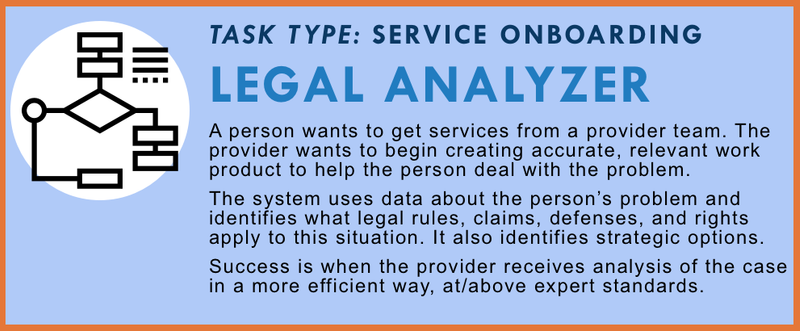Legal Analyzer

Analyze a person’s legal situation and surface the legal rules, rights, and strategies that apply.
Task Description
When a person turns to a legal help provider for assistance, the organization needs to quickly understand the legal dimensions of their problem. This often means identifying which laws apply, what rights the person may have, what claims or defenses could be raised, and what options exist for moving forward. Traditionally, this analysis requires significant legal training, experience, and time.
This task focuses on a system that serves as an issue analysis and strategy assistant. Using structured intake data and document inputs, the system maps out what legal frameworks govern the situation—what statutes or regulations are relevant, what common claims arise in similar cases, and what defenses may be available. It also identifies potential procedural steps, risks, and options that could form part of the legal response or service strategy.
The system doesn’t make legal decisions or offer final advice—but it equips providers with a strategic snapshot, grounded in local law and tailored to the facts of the case. This may include timelines, available remedies, risk flags, and citation-backed rationale for each identified rule or option. The goal is to improve both the speed and quality of early case assessment.
This is especially helpful in busy clinics or frontlines where experienced attorneys are stretched thin, or where non-attorneys are gathering case information that will later be reviewed. It also supports providers in spotting cross-cutting issues (e.g., immigration, disability, housing rights) and surfacing options that a newer staff member might miss.
Success means the provider team receives a clear, accurate, and jurisdiction-specific analysis of the client’s situation—at or above the level of an experienced issue spotter, but delivered faster and with structured outputs.
How to Measure Quality?
📚 Accuracy of Legal Framework Identification
- Correctly identifies relevant laws, claims, defenses, and rules for the user’s jurisdiction and facts
- Matches procedural posture (e.g., pre-filing, active case, post-judgment)
- Avoids overgeneralization or applying rules from inapplicable contexts
⚖️ Strategic Option Mapping
- Outlines multiple strategic paths (e.g., settlement, administrative review, court filing, negotiation)
- Provides trade-offs, timing, and risk levels for each path
- Highlights urgent deadlines, jurisdictional barriers, or resource constraints
📄 Supporting Citations and Explanations
- Provides links or references to supporting statutes, regulations, or court rules
- Explains the rationale behind each identified claim or defense in plain language
- Allows provider to see “why” a certain path or issue was surfaced
🧠 Customizability and Feedback Loop
- Allows provider to adjust facts or add new info to refine the analysis
- Flags assumptions or uncertain inferences for human review
- Improves over time with feedback on what issues or options were actually pursued
🧑💼 Workflow Integration
- Outputs structured data for use in draft pleadings, motions, or referrals
- Supports templated explanations or charts to aid client communication
- Works in tandem with intake tools, document review, and case management systems
⏱️ Efficiency and Expert Benchmarking
- Reduces time required to perform initial case analysis
- Matches or exceeds performance of experienced attorneys at identifying viable legal angles
- Boosts confidence of junior or non-attorney staff preparing cases for review